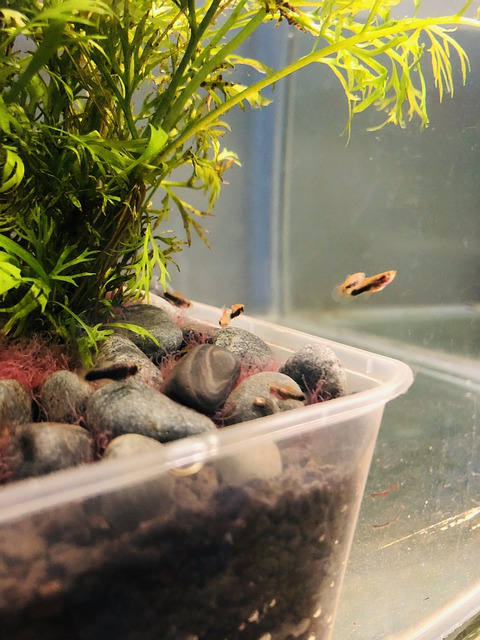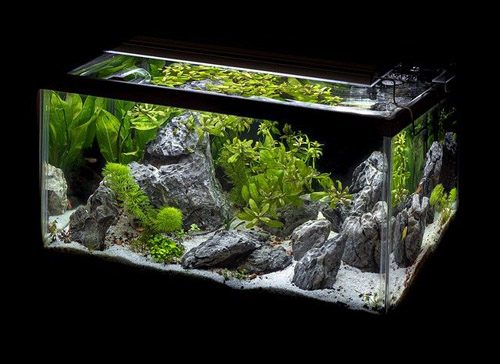The best way to clean rocks in a fish tank is using equipment called as a “siphon tube”. This includes a glass or plastic jar at one end and rubber tubing open at the other end. While using a siphon tube the opposite end of the tube that goes into an empty bucket must be kept at a lower level than the fish tank water level.
The way to clean stones, rocks and gravel bed in a fish tank is similar and requires not more than 30 to 45 minutes of time depending upon the setup of your tank.

Using a siphon tube you can suck out dirt particles that are firmly settling on the surfaces of the rocks and suck them out through the tube immediately as they get released. This prevents the dirt being spread and blown in the entire water column.
If you simply shuffle the gravel at the bottom, all the dirt and solid waste that is settling at the bottom and under the gravel for days quickly gets blown in the entire water column and it becomes really difficult to collect every tiny piece of dirt individually.
That is why a siphon tube helps to prevent the dirt from spreading in the entire tank and you can suck it easily out using the siphon method.
Table of Contents
Why are the rocks in my fish tank dirty?
The primary reason rocks become dirty in a fish tank is solid waste and uneaten food getting settled on the rock surfaces. Fish eat food every day and deposit sold waste right in the tank, that gets settled on the rocks and gravel surfaces.
If a cleaning schedule is not maintained, the dirt gets settled in the form of layers. When it becomes too much you can visibly see the rocks being covered with brownish dirt.
Another way dirt gets settled on the rocks is because fish do not eat all the food being fed to them and the uneaten particles get settled on the rock surfaces day by day causing layers on top of the other.
In some fish tanks that receive natural sunlight directly, algae growth is seen on rock surfaces. Though an alga is not dangerous to fish this can quickly go out of control causing the whole water to turn green.
When algae goes out of control it not only covers the entire rock and gravel surfaces, but start floating in the entire water column making it greenish in color. This looks ugly visually and must be controlled. In such cases you can remove the rocks and remove algae from rock surfaces.
How to clean decorative rocks?
Sometimes the fish tank has many decorating rocks apart from the bottom gravel and solid waste produced by fish also gets stuck on the surfaces of these rocks for many days. If not removed these start to decay releasing harmful ammonia in the water column.

If the bigger rocks are not firmly fixed to the bottom of the gravel you can remove them temporarily and rinse them in a bucket. Never rinse the decorative rocks that you remove from the tank in a sink under flowing water.
The reason is these rocks has colonies of beneficial bacteria residing on the surface and when you introduce them again in the tank these colonies start the process of decomposing the harmful gases into less harmful ones immediately. When you rinse the rocks in a bucket the water from the bucket can be introduced again in the tank.
What makes the rocks in a fish tank dirty?
Most of the times solid waste that fish generate after eating food gets settled on fish tank rocks and unless you forcefully clean them, they will continue to stay on the surfaces creating toxic gases and they start to decay.
This is not only a problem biologically but even visually as well. Fish will eat food every day and produce solid waste frequently. This crate layers of dirt on the rock surfaces unless you have a habit of cleaning them regularly.
Such layers of dirt are extremely toxic and can lead to serious trouble in a healthy fish tank if not cleaned on a regular basis.
How often should you clean the rocks in a fish tank?
If your tank cleaning schedule is once every week, then the schedule for your rock cleaning should be at least once in two months. While cleaning rocks it is necessary that you do not rinse them completely in sink flowing water because these rocks and other decorations contain big colonies of beneficial bacteria on their surfaces that need to be retained in fish tank water column once they get established.
These colonies are formed over a long period of time and during the cycling phase of the tank. Completely rinsing them can “shock” your fish once you introduce these rocks and decorations in again because all the beneficial bacteria have been removed during cleaning process. Such sudden shocks can be dangerous for fish and even death can occur.
How to clean fish tank rocks without vacuum?
The best way to clean fish tank rocks without vacuum is by removing them physically from fish tank and rinsing them in a bucket. The reason for this is that the water that gets rinsed can be reused because they contain colonies of beneficial bacteria on them that convert harmful gases into less harmful ones every day.
How to clean gravel and rocks using a siphon tube?
- A siphon tube is an easy to use instrument. It has a glass vertical jar at one end and rubber tube that is open at the other.
- The glass jar goes into the fish tank and open end of the tube goes into an empty bucket.
- The empty bucket must be kept at a lower level than the level of the fish tank water column so that water does not travel back in the tank.
- The glass jar is first filled with aquarium water by dipping completely and removed half way so that air inside the tube and the jar gets removed.
- After doing such multiple times all the air from the jar and the tube gets removed and siphon tube acts like a pump that starts to suck the water.
- While sucking the water, it also sucks dirt pieces along with it.
- The benefit of using a glass jar is that while sucking, the solid waste particles are confined into the jar area. If a jar is not used the dirt particles are likely to spread in the entire tank making it dirty all over.
- While cleaning gravel bed you can shuffle it slowly so that particles that are hidden at the bottom layers also get removed and get sucked into water.
- Since water also gets sucked it is necessary to check levels of water while cleaning gravel.
- It is necessary that no more than 25% water gets removed while cleaning gravel and rocks.
Here is a detailed video that shows how to use the “siphon tube” to suck out dirt particles.
How to prevent rocks and gravels from getting dirty?
The only way to prevent rocks and gravel from getting full of dirt is to stick to a strict maintenance and cleaning schedule using carefully selected equipment such as a “siphon tube”. Acquiring the right kind of cleaning and maintenance knowledge in this case helps a lot in creating healthy and happy environment for your fish. Every fish tank has it’s own properties and habitat. It takes a while for the fish tank owner to get the right knowledge of cleaning his set up over a period of time.
Fish are extremely sensitive to pH, water temperatures, tank mates and water chemistry. To get a hang of what works and what doesn’t it is necessary to experiment a lot and stick to habits that are healthy and beneficial for the fish species you have in your tank.
Fish are practically living in a tank full of toxic gases and as an owner it becomes necessary to create and maintain the perfect healthy ecosystem that fish find in the natural world so that they can live longer and are happy to play and breed.
Is it necessary to remove fish while cleaning rocks?
If you want to clean decorative rocks then it is not necessary to remove fish from the fish tank, instead you can safely remove decorative stones from the water column and then clean them in a rinsing bucket outside of the tank. Once cleaning is finished you can simply put the stones in their original positions in the fish tank.
Also while cleaning the gravel; it is not necessary to remove fish from the fish tank. When you use a siphon tube, it sucks water out of the tank. It is necessary that you pay attention to water levels. A 25% water change is advisable while cleaning water and other dirt from water column. Replacing more water than that is only necessary if you have a dead fish settling for a long time in the water column.
After your cleaning is done you must replace the removed water with de-chlorinated water. You can store another water bucket 24 hours prior to cleaning schedule and use it as a replacement.